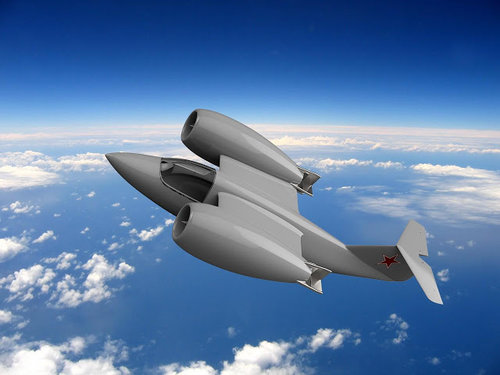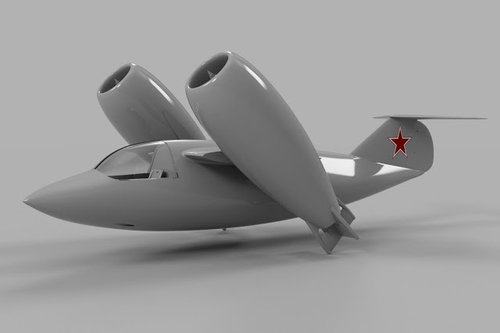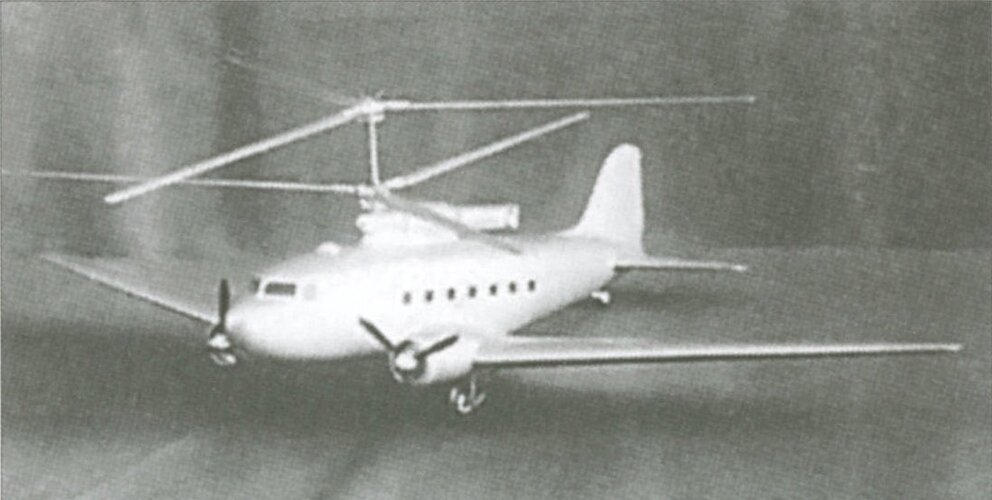You are using an out of date browser. It may not display this or other websites correctly.
You should upgrade or use an alternative browser.
You should upgrade or use an alternative browser.
Various Soviet & Russian VTOL Projects
- Thread starter hesham
- Start date
- Joined
- 31 July 2013
- Messages
- 568
- Reaction score
- 1,175
Further to posts 8 and 35 I came across these renderings of the VSI. All from https://www.72news.eu/2017/11/abk-shcherbakov-wsi-renders.htmlVSI fighter by Shchyerbakov
________________________________
VSI - (Vysoko-Skorostnoy Istrebitel):high-speed fighter.
1946-1947
Conceptually years ahead of its time, this was world's first project for vectored-thrust
jet VTOL.
Accounting velocity - before 1500 km/h (engines 2 x RD-45 (Nene)
Source: Shavrov "History design plane in USSR 1938-1950"



- Joined
- 26 May 2006
- Messages
- 34,800
- Reaction score
- 15,685
My dear Pometablava,
Please recieve my special message.
That designed I have no information about him,the A.G.Klimyenko
and his design of 1990,as VTOL executive aircraft project.
Hi,
Attachments
Motocar
I really should change my personal text
- Joined
- 16 May 2014
- Messages
- 1,065
- Reaction score
- 1,111
Good for speculative cutaway drawingHi,
A roadable VTOL project,the Lark-4.
Motocar
I really should change my personal text
- Joined
- 16 May 2014
- Messages
- 1,065
- Reaction score
- 1,111
The lateral cutaway drawing Lark-4, According to this brief side cutaway drawing, I don't see anything to be a VTOL, I can't identify any critical component for its use beyond a light aircraft. Shared from:

 alternathistory.com
alternathistory.com


Летающий автомобиль Lark-4 - Альтернативная История
Летающий автомобиль Lark-4 - Альтернативная История

- Joined
- 26 May 2006
- Messages
- 34,800
- Reaction score
- 15,685
The lateral cutaway drawing Lark-4, According to this brief side cutaway drawing, I don't see anything to be a VTOL, I can't identify any critical component for its use beyond a light aircraft. Shared from:

Летающий автомобиль Lark-4 - Альтернативная История
Летающий автомобиль Lark-4 - Альтернативная Историяalternathistory.com

I got it from a Russian site,it speaks only about VTOL aircraft ?!.
Erdosain
ACCESS: Secret
- Joined
- 10 March 2020
- Messages
- 476
- Reaction score
- 1,955
Further to posts 8 and 35 I came across these renderings of the VSI. All from https://www.72news.eu/2017/11/abk-shcherbakov-wsi-renders.html
View attachment 629729View attachment 629728View attachment 629730
The VSI High-Speed VTOL Fighter

The VSI fighter (Russian acronym for High-Speed Fighter) was an experimental fighter with VTOL properties, which was conceived in 1946 by Engineer Scherbakov, who completed the project in 1947, just after the closure of his design bureau.
The VSI was a high-wing, cantilever-type monoplane with a short span and no sweep, as well as a T-tail, equipped with a tricycle landing gear.
This VTOL fighter was to be powered by two turbojets installed in tilting nacelles at the wingtips. For control in hovering flight, there were “rudders” behind the nozzles to channel the exhaust gases. After a vertical takeoff, the engines – which were supposed to have a thrust-to-weight ratio greater than 1 – would rotate until they reached a horizontal position until they reached a speed that allowed horizontal flight. Landing would be a reverse process with gradual deceleration until the nacelles reached the vertical position.
Estimated performance was a maximum speed of 1,500 km/h and a range of 1,000 km.

A test bed was built to prove the concept at the Soviet Air Force Engineering Academy. As the expected weight of the VSI was 4 tons, two Rolls Royce Nene engines of 2,270 kg thrust were requested. These could not be obtained so the test vehicle was fitted with two Junkers Jumo 004 engines which had a thrust of 900 kg, clearly insufficient.
The test bed consisted of four large towers with the aircraft suspended between them by a cable for hovering tests. A simplified aircraft was built and tested during 1948, but after a time all work was suspended because the project was not promising under the existing conditions.

Source:
“Unflown Wings” Soviet and Russian Unrealized Aircraft Projects 1925-2010, by Yefim Gordon and Sergei Komissarov.
Erdosain
ACCESS: Secret
- Joined
- 10 March 2020
- Messages
- 476
- Reaction score
- 1,955
The Kamov Izdeliye Kh compound helicopter (1951)

This 1951 project was a strange attempt by Kamov to obtain a heavy helicopter, installing a three-bladed coaxial rotor and a 4,650 shp Kuznetsov TV-2 turboshaft in the upper fuselage area of a Lisunov Li-2 Cab, a Soviet variant of the Douglas DC-3 produced under license.
The mode of operation was as follows: during takeoff, the Li-2's 1,000 hp Shvetsov ASh-62 radial engines remained at idle while the TV-2 was brought to full power, raising the aircraft vertically to the necessary height. During this stage, the coaxial rotors were responsible for the lift and control of the aircraft.
Then the same lever that increased the power of the radial engines reduced that of the turboshaft to 1,000 shp. For cruise flight, power was provided by the radial engines while the aircraft was controlled by conventional control surfaces, with the coaxial rotor set to autorotation.
The Kh compound helicopter was intended to carry up to 25 soldiers, mortars, guns and light vehicles over distances of up to 400 kilometres. The planned performance was similar to that of the Li-2, but with the addition of vertical take-off and landing.
However, no prototype of the Kh compound helicopter was built, because by 1952 the Mil Mi-4 and Yakovlev Yak-24 heavy helicopters had already made their maiden flight, so there was no need for such an unorthodox helicopter.
A wind tunnel model was built, equipped with two coaxial rotors from the Kamov Ka-10 helicopter, but it did not progress beyond that stage and the project was cancelled in 1952.
Source: “Unflown Wings” Soviet and Russian Unrealised Aircraft Projects 1925-2010, by Yefim Gordon and
Attachments
Similar threads
-
Biesnovat Type-6 Unmanned Supersonic Airplane Project
- Started by hesham
- Replies: 1
-
Various Sukhoi projects and unknown designs
- Started by Armchair Admiral
- Replies: 98
-
MDP program - the Mikoyan Product 701
- Started by Tuomasn
- Replies: 30
-
UTS trainer competition: Yak-130, MiG-AT, Sukhoi S-54, Myasishchev M-200
- Started by Tuomasn
- Replies: 56
-









